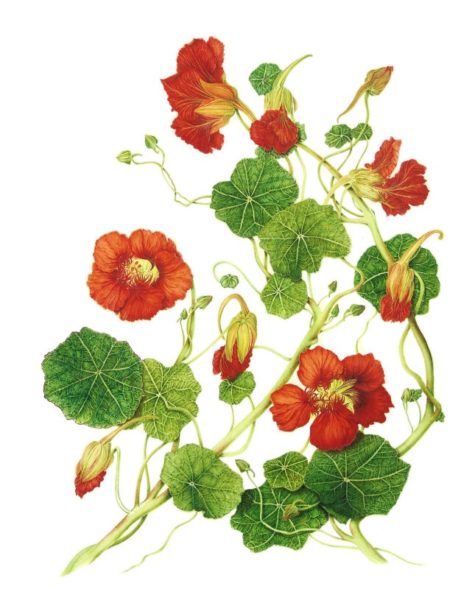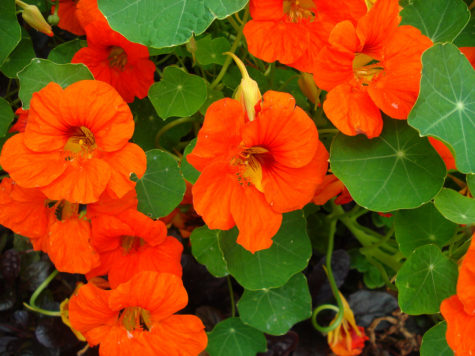Edible Flowers
Nasturtium
- Scientific name: Tropacolum majus
- Plant family: Tropaeolaceae
- Note: It should not be confused with watercress, whose Latin name is Nasturtium officinale.
- Parts Used: The fresh or dried leaves, flowers, and the seed pods.
- Medical Action: Anti-microbial, anti-bacterial, anti-viral
- Constituents: Glucosilinates; unknown anti-bacterial substance, vitamin C
The flowers contain about 130 mg vitamin C per 100 grams (3.5 oz), about the same amount as is contained in parsley. Moreover, they contain up to 45 mg of lutein per 100 gr, which is the highest amount found in any edible plant.
The Basics
Nasturtium is quite a powerful anti-microbial, especially when used as a local remedy for the treatment of bacterial infection. Internally it can be used with benefit in any bacterial infection but it is especially indicated for respiratory infections suchas bronchitis.
It has been found to be beneficial in influenza and the common cold. Some herbalists report it to be indicated in infections of the female reproductive organs.
Nasturtium is mostly taken fresh by adding leaves, flowers and seed pods into salads and other edibles. The plant is antimicrobial, so it is good to eat this herb for infections. It is useful for respiratory infections like bronchitis, flu and colds, and it is also helpful for reproductive infections. It can help clear mucous from the throat and lungs.
By taking herbal tincture when you first feel a cold coming on, you can help speed that cold on its way. The seed pods may be antifungal. Tinctures can be made in alcohol or vinegar to preserve the nutrients of the plant for later use. Vinegar can be put on cooked greens for a mustardy touch.
The mustard oils contained in nasturtium have an antibacterial and antiviral effect and can protect against infectious and undesired yeasts such as candida. They can be used to relieve pain, improve wound healing, treat digestive disorders and bladder infections and infections of the upper respiratory tract.
Description
Nasturtium is found in many gardens with its round flat leaves and bright cheery flowers. It comes in many different colors and some varieties have variegated leaves as well.
Nasturtium is both a decorative garden annual as well as a useful culinary herb. There are two types of nasturtium; a trailing type (Tropaeolum majus) that can be trained to climb or allowed to spread on the ground and a bush type (Tropaeolum minus) that forms loose mounds.
Nasturtium produces colorful flowers all summer and has attractive water lily-like foliage. It is useful as a plant for garden beds as well as for containers. The big beautiful flowers and leaves with their unusual shield-like shape are particularly striking and ornamental. The plant forms up to 4 m long shoots that bear flowers throughout the year.
Because it is not hardy, all this splendor sadly ends with the first frost. Continue reading
Rennie Luttrull: queen-annes-lace-seeds
Rosanna: Spignel aka Bald Money
Annamarie Squatrito: Fumitory
EILEEN Klinghagen: Pumpkin
Mahmudul Hasan: Celery



